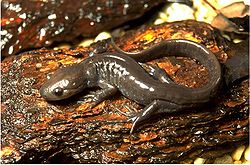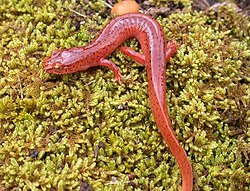This is a list of the amphibians that occur in the Shenandoah National Park in the Blue Ridge Mountains of western Virginia.
- Abundant refers to species that may be seen daily in its suitable habitat and season, and counted in relatively large numbers.
- Common denotes species that may be seen daily in its suitable habitat and season, but not in large numbers.
- Uncommon means a species is likely to be seen only monthly in its appropriate season and habitat, though it may be locally common.
- Rare refers to a species that is only seen a few times each year.
- Unknown is used when abundance has not been assessed.
| Mole Salamanders (Ambystomatidae) | |||
|---|---|---|---|
| Common name | Genus and species | Abundance | Picture |
| Jefferson salamander | Ambystoma jeffersonianum | Uncommon |  |
| Spotted salamander | Ambystoma maculatum | Uncommon |  |
| True Toads (Bufonidae) | |||
| American toad | Bufo americanus | Common |  |
| Fowler's toad | Bufo fowleri | Rare |  |
| Tree Frogs (Hylidae) | |||
| Northern cricket frog | Acris crepitans | Uncommon |  |
| Gray tree frog | Hyla versicolor | Uncommon |  |
| Spring peeper | Pseudacris crucifer | Uncommon |  |
| Upland chorus frog | Pseudacris triseriata feriarum | Uncommon |  |
| Lungless Salamanders (Plethodontidae) | |||
| Northern dusky salamander | Desmognathus fuscus | Abundant |  |
| Seal salamander | Desmognathus monticola | Common |  |
| Northern two-lined salamander | Eurycea bislineata | Abundant |  |
| Three-lined salamander | Eurycea longicauda guttolineata | Unknown |  |
| Longtail salamander | Eurycea longicauda longicauda | Rare |  |
| Spring salamander | Gyrinophilus porphyriticus | Uncommon |  |
| Four-toed salamander | Hemidactylium scutatum | Rare | |
| Red-backed salamander | Plethodon cinereus | Abundant | |
| White-spotted slimy salamander | Plethodon cylindraceus | Unknown |  |
| Shenandoah salamander | Plethodon shenandoah | Unknown (Endemic) |  |
| True Frogs (Ranidae) | |||
| American bullfrog | Rana catesbeiana | Uncommon |  |
| Green frog | Rana clamitans | Common |  |
| Pickerel frog | Rana palustris | Common |  |
| Wood frog | Rana sylvatica | Uncommon |  |
| True Salamanders and Newts (Salamandridae) | |||
| Eastern newt | Notophthalmus viridescens | Uncommon |  |